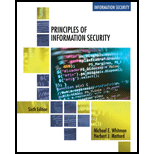
Concept explainers
a)
Explanation of Solution
Walls and Doors:
Walls and doors act as the obstacles and prevent form stealing resources or information...
b)
Explanation of Solution
Access Control:
Access control is categorized into two. They are:
Physical access control: The objective of physical access control is to guard the physical resources of a particular organization. The physical resources may be people, systems, hardware and so on.
Logical access control: The objective of physical access control is to guard the critical data that could be taken by an intruder without accessing physical devices. They are technology-based control that includes intrusion detection system, antivirus software, and firewalls.
Factors considered for the server room:
The organization will consider many security controls to protect their resources and precious data...
c)
Explanation of Solution
Fire detection:
Fire detectors are used to find out the phenomena resulting from fire like, smoke, gas, ultraviolet radiation, infrared radiation, etc. By using fire detectors, it is possible to save lots of lives and protects assets in an organization...
d)
Explanation of Solution
Fire suppression:
- Fire suppressor is used to eliminate fire from particular areas. They are of portable and manual types. Mostly portable extinguishers are more efficient for smaller fire.
- Fire suppression system quells fires by eliminating either oxygen or fuel, or it reduces the temperature.
- Fire extinguishers usually contain carbon-di-oxide that eliminates oxygen supply. It might harm living beings so they are not used in residential areas...
e)
Explanation of Solution
Heating, Ventilating, and air conditioning:
Heating, ventilation as well as air conditioning system could have impact on operations of
f)
Explanation of Solution
Power quality and distribution:
In order to avoid power quality, proper UPS should be used. They act as a backup power supply for computers. The powering capacity of UPS is usually measured in volt-ampere. A normal computer uses 200 VA and during interruptions or power fluctuations, it gets efficient power supply from UPS which provides up to 1,000 VA...
Trending nowThis is a popular solution!

Chapter 9 Solutions
Principles Of Information Security, Loose-leaf Version
- Could you help me to know features of the following concepts: - commercial CA - memory integrity - WMI filterarrow_forwardBriefly describe the issues involved in using ATM technology in Local Area Networksarrow_forwardFor this question you will perform two levels of quicksort on an array containing these numbers: 59 41 61 73 43 57 50 13 96 88 42 77 27 95 32 89 In the first blank, enter the array contents after the top level partition. In the second blank, enter the array contents after one more partition of the left-hand subarray resulting from the first partition. In the third blank, enter the array contents after one more partition of the right-hand subarray resulting from the first partition. Print the numbers with a single space between them. Use the algorithm we covered in class, in which the first element of the subarray is the partition value. Question 1 options: Blank # 1 Blank # 2 Blank # 3arrow_forward
- 1. Transform the E-R diagram into a set of relations. Country_of Agent ID Agent H Holds Is_Reponsible_for Consignment Number $ Value May Contain Consignment Transports Container Destination Ф R Goes Off Container Number Size Vessel Voyage Registry Vessel ID Voyage_ID Tonnagearrow_forwardI want to solve 13.2 using matlab please helparrow_forwarda) Show a possible trace of the OSPF algorithm for computing the routing table in Router 2 forthis network.b) Show the messages used by RIP to compute routing tables.arrow_forward
- using r language to answer question 4 Question 4: Obtain a 95% standard normal bootstrap confidence interval, a 95% basic bootstrap confidence interval, and a percentile confidence interval for the ρb12 in Question 3.arrow_forwardusing r language to answer question 4. Question 4: Obtain a 95% standard normal bootstrap confidence interval, a 95% basic bootstrap confidence interval, and a percentile confidence interval for the ρb12 in Question 3.arrow_forwardusing r languagearrow_forward
- using r languagearrow_forwardusing r language Obtain a bootstrap t confidence interval estimate for the correlation statistic in Example 8.2 (law data in bootstrap).arrow_forwardusing r language Compute a jackknife estimate of the bias and the standard error of the correlation statistic in Example 8.2.arrow_forward
 Principles of Information Security (MindTap Cours...Computer ScienceISBN:9781337102063Author:Michael E. Whitman, Herbert J. MattordPublisher:Cengage Learning
Principles of Information Security (MindTap Cours...Computer ScienceISBN:9781337102063Author:Michael E. Whitman, Herbert J. MattordPublisher:Cengage Learning Principles of Information Systems (MindTap Course...Computer ScienceISBN:9781285867168Author:Ralph Stair, George ReynoldsPublisher:Cengage Learning
Principles of Information Systems (MindTap Course...Computer ScienceISBN:9781285867168Author:Ralph Stair, George ReynoldsPublisher:Cengage Learning Principles of Information Systems (MindTap Course...Computer ScienceISBN:9781305971776Author:Ralph Stair, George ReynoldsPublisher:Cengage Learning
Principles of Information Systems (MindTap Course...Computer ScienceISBN:9781305971776Author:Ralph Stair, George ReynoldsPublisher:Cengage Learning Management Of Information SecurityComputer ScienceISBN:9781337405713Author:WHITMAN, Michael.Publisher:Cengage Learning,
Management Of Information SecurityComputer ScienceISBN:9781337405713Author:WHITMAN, Michael.Publisher:Cengage Learning, Operations Research : Applications and AlgorithmsComputer ScienceISBN:9780534380588Author:Wayne L. WinstonPublisher:Brooks Cole
Operations Research : Applications and AlgorithmsComputer ScienceISBN:9780534380588Author:Wayne L. WinstonPublisher:Brooks Cole Systems ArchitectureComputer ScienceISBN:9781305080195Author:Stephen D. BurdPublisher:Cengage Learning
Systems ArchitectureComputer ScienceISBN:9781305080195Author:Stephen D. BurdPublisher:Cengage Learning





